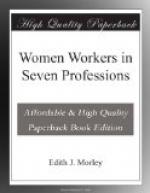Apparently the Government policy, as evidenced by its maintenance grants, is to discourage women students from entering residential colleges. Yet it is a well-known fact that the wear and tear involved in living at home is far greater than at college—especially for women—and the educational advantages correspondingly fewer than those resulting from residence.
County Councils frequently provide “free places” at local colleges, together, in some cases, with supplementary bursaries for maintenance. Non-resident students—e.g., in London—seldom have any out-of-pocket expenses for their actual education. Nor must it be forgotten that education up to college age is free to junior county scholars and to bursars, who also receive small grants towards maintenance.
College Fees for other than Elementary Teachers-in-Training[2]
Oxford and Cambridge Colleges From
L90 to L105 a year for a
minimum of 3 years
(of 24 weeks).
Other Residential Universities
and Colleges From L52 to L90
or L110 a
year for a minimum
of 3
years (of 30 to
35 weeks).
Non-residential Colleges From
L20 to L55 a year for a
minimum of 3 years.
(The
cost of maintenance
must be
reckoned at about
L40 a
year, as a minimum.)
Students who desire to do advanced work will need at least one, and probably two, additional years at the University, while all women who intend to teach in schools ought also to spend one year in training.
A large number of County Councils provide “senior” scholarships to cover or partially to cover college fees. In some counties only one or two such scholarships are given annually, and there is severe competition: in others they are comparatively easy to obtain, though there are never enough for all candidates who desire a University education. Most of these scholarships are not renewable for a fourth year of training—an extremely short-sighted policy on the part of the authorities.
At practically every University, entrance or other scholarships and exhibitions are awarded annually. Competition for these is usually very severe, and they are extremely difficult to gain. At Oxford and Cambridge only quite exceptional candidates can hope to secure scholarships at the women’s colleges. Moreover, scholarships seldom cover the complete cost of maintenance and tuition; at Oxford and Cambridge they never do so.
Most secondary teachers, then, must incur liabilities varying from L60 to L350, apart from school, holiday, and personal expenses, before they obtain their first degree. On the other hand, a graduate with good testimonials can very often obtain her professional training at comparatively small cost by means of a bursary: with luck, she may get maintenance as well as free tuition. Every year, however, as training is more widely recognised as essential, the proportion of scholarships available becomes smaller. With the advent of the new Teachers’ Register, which makes training indispensable after 1918, girls will more and more often be obliged to find means to pay for their own training. At present it is often possible to borrow for this purpose from loan societies specially formed to meet the needs of women preparing to enter professions.




